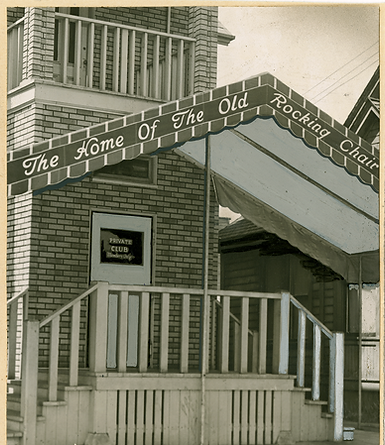

The Rocking Chair
115 S. Washington St.
The Rocking Chair was the most exclusive and illustrious of all the Seattle after-hours clubs and also sparked the career of its most famous citizen — Ray Charles, Genius of Soul. Known then as R.C. Robinson — to his friends, just “R.C.” — the blind singer/pianist came to Seattle from Tampa, Florida, in 1948, when he was 17 years old, with guitarist Garcia McKee. In the summer of ’48 they added Seattle bassist Milt Garred, and the trio landed a steady gig at the Rocking Chair. By all accounts, they tore the place up.
“You could be outside, and the house would be swaying,” recalled McKee, “going to and fro [because of] the vibration of the people that were dancing.”
The Rocking Chair was ensconced in a tall two-story house with a fake brick facade and gabled porch that stood where the parking lot of Bailey Gatzert School is now. Fancier than many other night spots, it had leather upholstered booths with a red-and-black color scheme. Drinks of high-quality bonded liquor could be had from barkeeps who served behind a glass-block bar. The band played on the ground floor in a room that comfortably held 75 people but was sometimes packed to 100. Upstairs, two rooms offered gambling and, sporadically, fried chicken.
Security was tight.
“You had to ring the doorbell and they’d see if they let you in or not,” said Zenobia, who often worked on the scene as an exotic dancer. “It had two doors: let you in one, then you had to go through the other door.”

Bar at the Rocking Chair.
(Museum of History & Industry, Al Smith Collection, 2014.49.16.040.11)

Down Beat Records promotional photo for the Maxin Trio. The unusual name combined parts of the players’ names: R.C. Robinson, Garcia McKee and Milt Garred.
(Courtesy of Melody Jones)
The Old Rocking Chair in 1945. (Museum of History & Industry, Seattle Post-Intelligencer Collection, 2000.107.174.16.01, photo by Stuart B. Hertz)

According to pianist Elmer Gill, who played at the Rocking Chair for several months in 1946, if an agent from the liquor board came through the first door, “they had a secret button to push on, under the carpet, and it would make lights flash inside, in the bar. They’d pour all the whisky down the drain and everybody would be drinking Coca-Cola when they’d get in there.”
The music sometimes carried on till 4 a.m., but no matter what time you left, a fellow out front called “Cabdaddy” was happy to hail you a taxi. Charles may have had Cabdaddy in mind — not to mention Seattle’s soggy weather — when he recorded the trio’s 1949 single “Rocking Chair Blues”:
I’m tellin’ you, it’s the gonest place in town
If you don’t have your rubbers, take a taxi down
The Rocking Chair began life in 1933 as the Blue Rose, more than a decade before Charles made it famous, and was operated first by Bill Bowman, then Alec Taylor. It was frequently shut down by police raids. In 1939, Harvey Owens advertised the place as the Blue Rose Chicken Shack. In 1945, the place reopened as the Old Rocking Chair, operated by “Big” Lewis Richardson, an old friend of the great band leader Count Basie, who had gotten married in Seattle five years earlier to a woman he met in Philadelphia, Catherine Morgan. Elmer Gill recalled seeing Basie at the club whenever he came to town with his band, as well as other famous musicians, including saxophonist Wardell Gray and trumpeter Thad Jones. Traveling stars had to be on their toes, however, lest the local competition come by to challenge them.
“There were lots of musicians roaming the streets who’d blow your ass off the stand if you gave ’em half the chance,” recalled Charles in his as-told-to autobiography, Brother Ray.
The Rocking Chair was crucial to Charles’ career. While he was playing there one night, a Los Angeles record producer asked him to make his first recording. In 1950, Charles left Seattle —– and his Seattle trio — for L.A. Shortly after that, the old house at 115 14th Ave. S. became an American Legion Club, though the venue continued to present music under various names throughout the ’50s and ’60s.

Ad, Northwest Enterprise,
August 28, 1946.

November 16, 1933. The Northwest Enterprise. The paper expresses the hope that Blue Rose employees will join the Elks Club.

Site of the Rocking Chair, 2024. The house stood at the center of this view of the Bailey Gatzert Elementary School parking lot.